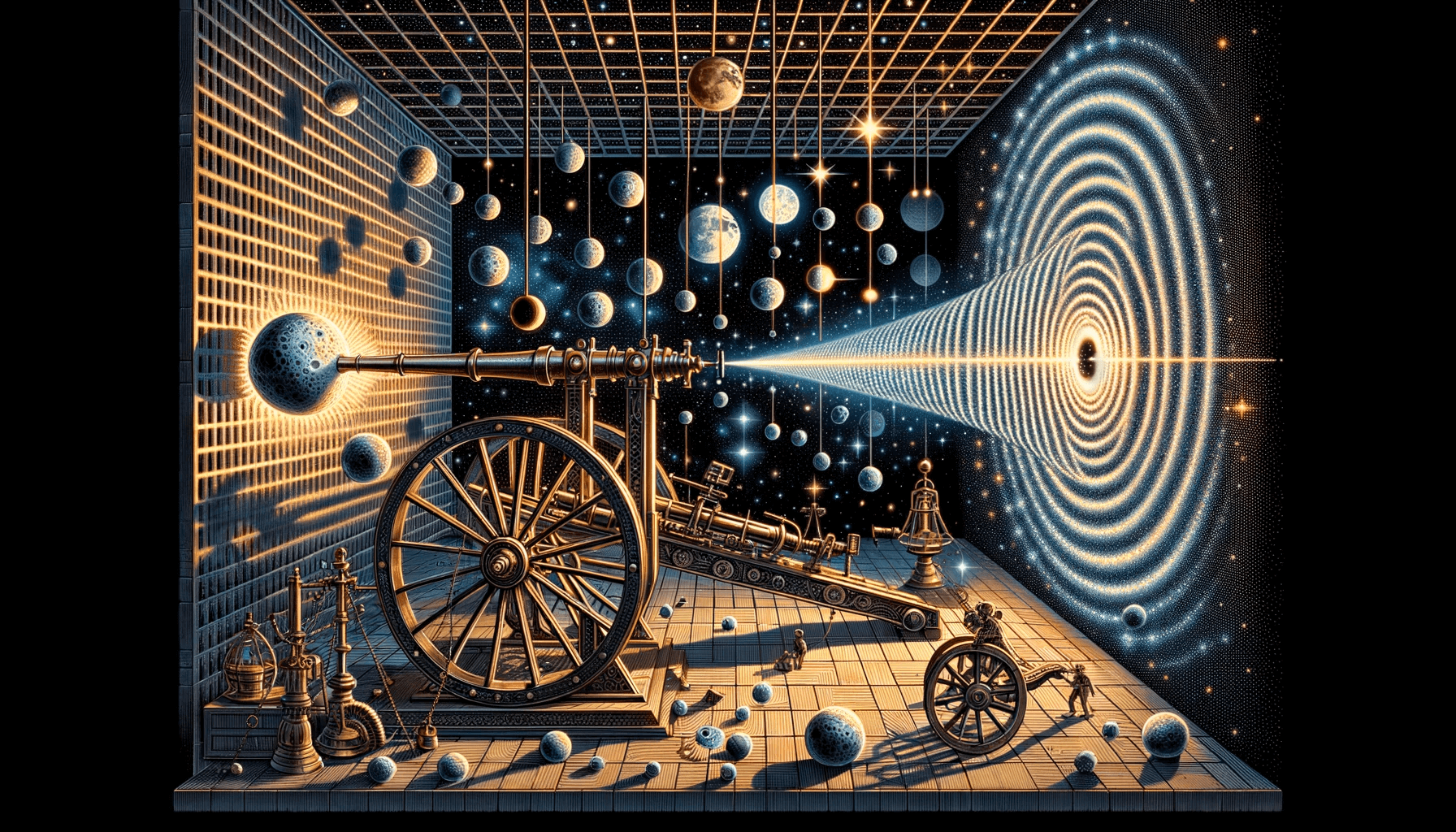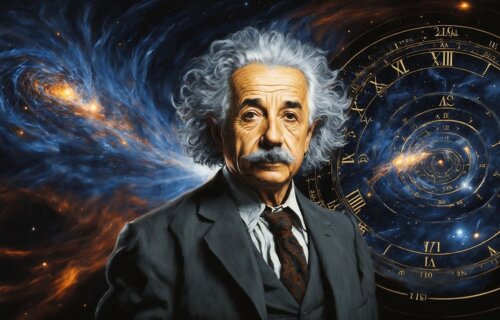LONDON — Albert Einstein once said, “Logic will get you from A to B. Imagination will take you everywhere.” Now, thanks to the creative power of University College London physicists, a new theory is challenging the longstanding discrepancy between Einstein’s theory of general relativity and quantum theory. This new theory reconciles the concepts of gravity and quantum mechanics, while still holding onto the famous physicist’s understanding of spacetime.
At the core of modern physics lie these two fundamental pillars: quantum theory, governing the behavior of the tiniest particles, and Einstein’s theory of general relativity, explaining gravity through the bending of spacetime. However, these theories clash, presenting a challenge that has persisted for over a century.
Scientists traditionally believed that reconciling these theories required modifying Einstein’s theory to fit within quantum theory, as attempted by leading theories like string theory and loop quantum gravity. However, the new theory is challenging this consensus.
In the theory termed a “postquantum theory of classical gravity,” rather than altering spacetime, quantum theory undergoes modification. This suggests that spacetime might not be governed by quantum theory at all. Instead, the theory predicts unpredictable fluctuations in spacetime larger than those predicted by quantum theory, causing objects’ apparent weights to become unpredictable under precise measurements.

A simultaneous paper is also exploring the theory’s implications and proposes an experiment to test it. This experiment involves precisely measuring the weight of a one-kilogram mass over time at the International Bureau of Weights and Measures in France. If fluctuations in measurements surpass expected limits, it could refute the theory.
For five years, the UCL research group has scrutinized and tested this theory.
“Quantum theory and Einstein’s theory of general relativity are mathematically incompatible with each other, so it’s important to understand how this contradiction is resolved. Should spacetime be quantized, or should we modify quantum theory, or is it something else entirely?” questions study author Jonathan Oppenheim, professor of physics and astronomy at UCL, in a university release. “Now that we have a consistent fundamental theory in which spacetime does not get quantized, it’s anybody’s guess.”
Study co-author Zach Weller-Davies, who as a PhD student at UCL helped develop the experimental proposal and made key contributions to the theory itself, emphasized the experimental implications.
“In both quantum gravity and classical gravity, spacetime must be undergoing violent and random fluctuations all around us, but on a scale which we haven’t yet been able to detect,” explains Weller-Davies. “But if spacetime is classical, the fluctuations have to be larger than a certain scale, and this scale can be determined by another experiment where we test how long we can put a heavy atom in superposition of being in two different locations.”

Study co-author Dr. Barbara Šoda expressed hope that these experiments could settle the debate about pursuing a quantum theory of gravity.
“Because gravity is made manifest through the bending of space and time, we can think of the question in terms of whether the rate at which time flows has a quantum nature, or classical nature,” notes Dr. Šoda. “And testing this is almost as simple as testing whether the weight of a mass is constant, or appears to fluctuate in a particular way.”
The theory’s origins lie in resolving the black hole information problem, allowing for information destruction due to a breakdown in predictability, a departure from standard quantum theory.
This novel theory not only challenges current paradigms but also offers new perspectives for experimental testing, potentially reshaping our understanding of gravity and spacetime.
The study is published in the journal Physical Review X.
You might also be interested in:
- Einstein proven right again! Study of extreme stars confirms theory of general relativity
- Can we time travel? Scientists use quantum physics to show how it’s possible
- Does the multiverse really exist? If it does, our basic math may be wrong


Science of time and the theory of everything revised edition by Bhausaheb Bhosle has all the answers related to the theory of everything retaining the same word and the same meaning. Time bound time dependent theory.
Proof Relativity is an optical illusion: According to Relativity, two inertial moving observers will see each others space contract and time dilate. This is a complete contradiction and a physical impossibility if the effects are real. Objects and the passage of time can not be both small and large at the same time. The only possible explanation is that the observed effects are an optical illusion. Any theory based on Special Relativity, such as General Relativity, must also have the same problem.
Hi my name is Dr William Walker and I am a PhD physicist and have been investigating this topic for 30 years. It has been known since the late 1700s by Simone LaPlace that nearfield Gravity is instantaneous by analyzing the stability of the orbits of the planets about the sun. This is actually predicted by General Relativity by analyzing the propagating fields generated by an oscillating mass. In addition, General Relativity predicts that in the farfield Gravity propagates at the speed of light. The farfield speed of gravity was recently confirmed by LIGO.
Recently it has been shown that light behaves in the same way by using Maxwell’s equations to analyze the propagating fields generated my an oscillating charge. For more information search: William Walker Superluminal. This was experimentally confirmed by measuring radio waves propagating between 2 antennas and separating the antennas from the nearfield to the farfield, which occurs about 1 wavelength from the source. This behavior of gravity and light occurs not only for the phase and group speed, but also the information speed.
This instantaneous nature of light and gravity near the source and been kept from the public and is not commonly known. The reason is that it shows that both Special Relativity and General Relativity are wrong! It can be easily shown that Instantaneous nearfield light yields Galilean Relativity and farfield light yields Einstein Relativity. This is because in the nearfield, gamma=1since c= infinity, and in the farfield, gamma= the Relativistic gamma since c= farfield speed of light. Since time and space are real, they can not depend on the frequency of light used. This is because c=wavelength x frequency, and 1 wavelength = c/frequency defines the nearfield from the farfield. Consequently Relativity is an optical illusion. Objects moving near the speed of light appear to contract in length and time appears to slow down, but it is just what you see using farfield light. Using nearfield light you will see that the object has not contracted and time has not changed. For more information: Search William Walker Relativity.
Since General Relativity is based on Special Relativity, General Relativity must also be an optical illusion. Spacetime is flat and gravity must be a propagating field. Researchers have shown that in the weak field limit, which is what we only observe, General Relativity reduces to Gravitoelectromagnetism, which shows gravity can be modeled as 4 Maxwell equations similar in form to those for electromagnetic fields, yielding Electric and Magnetic components of gravity. This theory explains all gravitational effects as well as the instantaneous nearfield and speed of light farfield propagating fields.
So gravity is a propagating field that can finally be quantized enabling the unification of gravity and quantum mechanics. The current interpretation if quantum mechanics makes no sense, involving particles that are not real until measured, and in a fuzzy superposition of states. On the other hand, the Pilot Wave interpretation of Quantum Mechanics makes makes much more sense, which says particles are always real with real positions and velocities. The particles also interact with an energetic quantum field that permeates all of space, forming a pilot wave that guides the particle. This simpler explainatiin explains all known quantum phenomena. The only problem is that the Pilot Wave is known to interact instantaneously with the particle and all other particles, and this is completely incompatible with Relativity, but is compatible with Galilean Relativity. So due to the evidence presented here, this is no longer a problem, and elevates the Pilot Interpretation to our best explanation of Quantum Mechanics
YouTube presentation of above argument:
https://www.youtube.com/watch?v=sePdJ7vSQvQ&t=0s
Paper it is based on: William D. Walker and Dag Stranneby, A New Interpretation of Relativity, 2023:
http://vixra.org/abs/2309.0145
Relativity is an optical illusion. According to Relativity, two inertial moving observers will see each others space contract and time dilate. This is a complete contradiction and a physical impossibility if the effects are real. Objects and the passage of time can not be both small and large at the same time. The only possible explanation is that the observed effects are an optical illusion. Any theory based on Special Relativity, such as General Relativity, must also have the same problem.
Hi my name is Dr William Walker and I am a PhD physicist and have been investigating this topic for 30 years. It has been known since the late 1700s by Simone LaPlace that nearfield Gravity is instantaneous by analyzing the stability of the orbits of the planets about the sun. This is actually predicted by General Relativity by analyzing the propagating fields generated by an oscillating mass. In addition, General Relativity predicts that in the farfield Gravity propagates at the speed of light. The farfield speed of gravity was recently confirmed by LIGO.
Recently it has been shown that light behaves in the same way by using Maxwell’s equations to analyze the propagating fields generated my an oscillating charge. For more information search: William Walker Superluminal. This was experimentally confirmed by measuring radio waves propagating between 2 antennas and separating the antennas from the nearfield to the farfield, which occurs about 1 wavelength from the source. This behavior of gravity and light occurs not only for the phase and group speed, but also the information speed.
This instantaneous nature of light and gravity near the source and been kept from the public and is not commonly known. The reason is that it shows that both Special Relativity and General Relativity are wrong! It can be easily shown that Instantaneous nearfield light yields Galilean Relativity and farfield light yields Einstein Relativity. This is because in the nearfield, gamma=1since c= infinity, and in the farfield, gamma= the Relativistic gamma since c= farfield speed of light. Since time and space are real, they can not depend on the frequency of light used. This is because c=wavelength x frequency, and 1 wavelength = c/frequency defines the nearfield from the farfield. Consequently Relativity is an optical illusion. Objects moving near the speed of light appear to contract in length and time appears to slow down, but it is just what you see using farfield light. Using nearfield light you will see that the object has not contracted and time has not changed. For more information: Search William Walker Relativity.
Since General Relativity is based on Special Relativity, General Relativity must also be an optical illusion. Spacetime is flat and gravity must be a propagating field. Researchers have shown that in the weak field limit, which is what we only observe, General Relativity reduces to Gravitoelectromagnetism, which shows gravity can be modeled as 4 Maxwell equations similar in form to those for electromagnetic fields, yielding Electric and Magnetic components of gravity. This theory explains all gravitational effects as well as the instantaneous nearfield and speed of light farfield propagating fields.
So gravity is a propagating field that can finally be quantized enabling the unification of gravity and quantum mechanics. The current interpretation if quantum mechanics makes no sense, involving particles that are not real until measured, and in a fuzzy superposition of states. On the other hand, the Pilot Wave interpretation of Quantum Mechanics makes makes much more sense, which says particles are always real with real positions and velocities. The particles also interact with an energetic quantum field that permeates all of space, forming a pilot wave that guides the particle. This simpler explanation explains all known quantum phenomena. The only problem is that the Pilot Wave is known to interact instantaneously with the particle and all other particles, and this is completely incompatible with Relativity, but is compatible with Galilean Relativity. So due to the evidence presented here, this is no longer a problem, and elevates the Pilot Interpretation to our best explanation of Quantum Mechanics. For more information search: Youtube William Walker Relativity